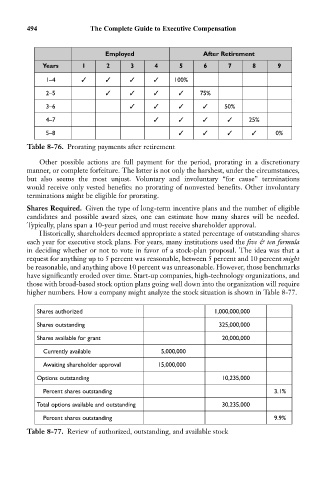Page 508 - Bruce Ellig - The Complete Guide to Executive Compensation (2007)
P. 508
494 The Complete Guide to Executive Compensation
Employed After Retirement
Years 1 2 3 4 5 6 7 8 9
1–4 100%
2–5 75%
3–6 50%
4–7 25%
5–8 0%
Table 8-76. Prorating payments after retirement
Other possible actions are full payment for the period, prorating in a discretionary
manner, or complete forfeiture. The latter is not only the harshest, under the circumstances,
but also seems the most unjust. Voluntary and involuntary “for cause” terminations
would receive only vested benefits: no prorating of nonvested benefits. Other involuntary
terminations might be eligible for prorating.
Shares Required. Given the type of long-term incentive plans and the number of eligible
candidates and possible award sizes, one can estimate how many shares will be needed.
Typically, plans span a 10-year period and must receive shareholder approval.
Historically, shareholders deemed appropriate a stated percentage of outstanding shares
each year for executive stock plans. For years, many institutions used the five & ten formula
in deciding whether or not to vote in favor of a stock-plan proposal. The idea was that a
request for anything up to 5 percent was reasonable, between 5 percent and 10 percent might
be reasonable, and anything above 10 percent was unreasonable. However, those benchmarks
have significantly eroded over time. Start-up companies, high-technology organizations, and
those with broad-based stock option plans going well down into the organization will require
higher numbers. How a company might analyze the stock situation is shown in Table 8-77.
Shares authorized 1,000,000,000
Shares outstanding 325,000,000
Shares available for grant 20,000,000
Currently available 5,000,000
Awaiting shareholder approval 15,000,000
Options outstanding 10,235,000
Percent shares outstanding 3.1%
Total options available and outstanding 30,235,000
Percent shares outstanding 9.9%
Table 8-77. Review of authorized, outstanding, and available stock

